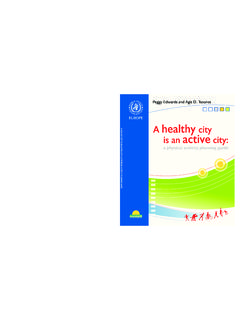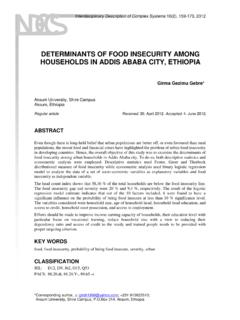Transcription of Healthy Cities - promoting health and equity
1 Healthy Cities promoting health and equity evidence for local policy and practice Summary evaluation of Phase V of the WHO European Healthy Cities Network Edited by: Evelyne de Leeuw, Agis D. Tsouros, Mariana Dyakova and Geoff Green Abstract This publication summarizes the evaluation of Phase V (2009 2013) of the WHO European Healthy Cities Network. The evaluation process was designed in collaboration with city representatives, academic institutions and public health experts. It adopted a realist synthesis approach, being responsive to the unique social, cultural, political, health and epidemiological circumstances in the 99 Cities in the WHO European Healthy Cities Network and 20.
2 Accredited national networks. The evaluation findings are rooted in the enduring Healthy city values such as equity , governance, partnership, participation and sustainability. Considering also the core Phase V themes, this publication focuses on policy and governance, Healthy urban environments and design, caring and supportive environments, Healthy and active living, national network performance and effects on health and equity . The evaluation finds good progress among Cities and networks but differing in scale and quality. The Healthy Cities movement adds value and allows local governments to invest in health and well-being and address inequities through novel approaches to developing health .
3 Keywords Cities . health POLICY. PUBLIC health Address requests about publications of the WHO Regional Office for Europe to: URBAN health Publications URBAN health SERVICES WHO Regional Office for Europe UN City Marmorvej 51. DK-2100 Copenhagen , Denmark ISBN 978 92 890 5069 2 Alternatively, complete an online request form for documentation, health information, or for permission to quote or translate, on the Regional Office web site (http://www. ). World health Organization 2014. All rights reserved. The Regional Office for Europe of the World health Organization welcomes requests for permission to reproduce or translate its publications, in part or in full.
4 The designations employed and the presentation of the material in this publication do not imply the expression of any opinion whatsoever on the part of the World health Organization concerning the legal status of any country, territory, city or area or of its authorities, or concerning the delimitation of its frontiers or boundaries. Dotted lines on maps represent approximate border lines for which there may not yet be full agreement. The mention of specific companies or of certain manufacturers' products does not imply that they are endorsed or recommended by the World health Organization in preference to others of a similar nature that are not mentioned.
5 Errors and omissions excepted, the names of proprietary products are distinguished by initial capital letters. All reasonable precautions have been taken by the World health Organization to verify the information contained in this publication. However, the published material is being distributed without warranty of any kind, either express or implied. The responsibility for the interpretation and use of the material lies with the reader. In no event shall the World health Organization be liable for damages arising from its use. The views expressed by authors, editors, or expert groups do not necessarily represent the decisions or the stated policy of the World health Organization.
6 Text editing: David Breuer Design: Christophe Lanoux Cover photo Sheffield Hallam University Contents Contributors iv Acknowledgements v Foreword vi Summary 1. 1. Phase V prerequisites and designation 2. 2. Methodology 4. 3. Enduring values 6. 4. Policy and governance 8. 5. Healthy urban environment and design 10. 6. Caring and supportive environments 12. 7. Healthy and active living 14. 8. National Healthy Cities networks in Europe 16. 9. health and equity 18. 10. Towards Phase VI 20. Annex 1. Members of the WHO European Healthy Cities Network in Phase V 22.
7 Iii Contributors Evelyne de Leeuw, La Trobe University, Melbourne and Glocal health Consultants, Melbourne, Australia Mariana Dyakova, WHO Regional Office for Europe Jill Farrington, Nuffield Centre for International health and Development, University of Leeds, United Kingdom Johan Faskunger, consultant, physical activity and public health , ProActivity AB, Tullinge, Sweden Marcus Grant, WHO Collaborating Centre for Healthy Urban Environments, University of the West of England, Bristol, United Kingdom Geoff Green, Centre for health & Social Care Research, Sheffield Hallam University, United Kingdom Erica Ison, health impact assessment and health in all policies, c/o National Knowledge Service, Oxford, United Kingdom Josephine Jackisch, WHO Regional Office for Europe Ilona Kickbusch, Global health Programme, Graduate Institute, Geneva, Switzerland Leah Janss Lafond, Women's Sports Network, London, United Kingdom Helen Lease, WHO Collaborating Centre for Healthy Urban Environments, University of the West of England, Bristol.
8 United Kingdom Karolina Mackiewicz, WHO Collaborating Centre for Healthy Cities & Urban health in the Baltic Region, Turku, Finland Maria Palianopoulou, WHO Regional Office for Europe Nicola Palmer, WHO Regional Office for Europe and La Trobe University, Melbourne, Australia Anna Ritsatakis, independent consultant, health policy development, Athens, Greece Gabriel Scally, WHO Collaborating Centre for Healthy Urban Environments, University of the West of England, Bristol, United Kingdom Jean Simos, Institute for Environment Sciences and Faculty of Medicine, University of Geneva, Switzerland Lucy Spanswick, WHO Regional Office for Europe and La Trobe University, Melbourne, Australia Agis D.
9 Tsouros, WHO Regional Office for Europe Premila Webster, Nuffield Department of Population health , Oxford University, United Kingdom Gianna Zamaro, Healthy City Project, Municipality of Udine, Italy iv Acknowledgements We would like to thank all Cities in the WHO European Healthy Cities Network and national network coordinators for their continuing commitment and active role from shaping and testing the data collection tools to providing impressive quantities of material and questionnaire response rates. In particular, we acknowledge the members of our advisory groups who joined us in Brussels, Belfast, Izmir and Copenhagen and contributed significantly to the evaluation process.
10 Special thanks to our thematic research teams and their leads for producing more than 600 pages of evaluation reports on which this summary is based. In addition, we would like to acknowledge the support from Connie Petersen, Leah Janss Lafond, Per-Olof stergren and Terese Olsson- Kumlin. We have also been continually encouraged and challenged by our critical friends June Crown and Niels Rasmussen your guidance has been key to the successful completion of this project. All the hard work of the evaluation, including extensive data collection, coding, quality check, analysis, interpretation and presentation, would not have been possible without the substantive and relentless support of the Australian interns Lucy Spanswick, Nicola Palmer and Marian Biddle.
















